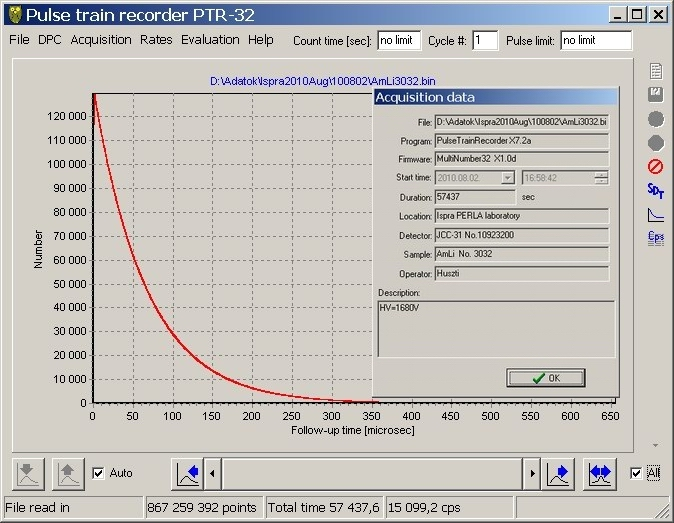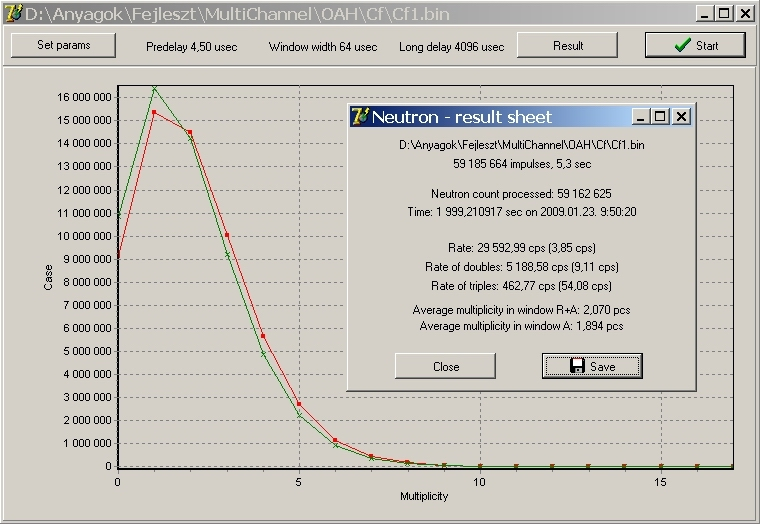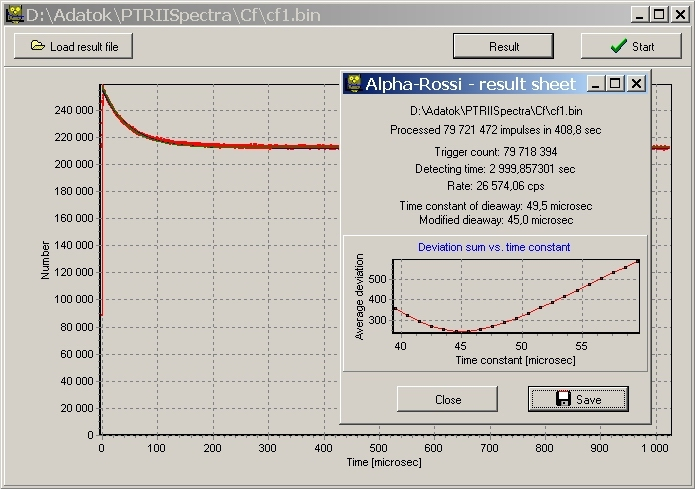Data acquisition program for neutron coincidence counting
The PulseTrainRecorder software under Windows XP and Windows 7 can control data acquisition with all versions of PTR hardware. The software has an extensive user manual. Main features are:
- Automatic recognition of channel number handling
- Automatic recognition of built-in high voltage supply
- Software controlled high voltage unit
- Time and impulse number limits
- Repeated measurements
- Follow-up distribution is permanently displayed
- Graph is expandable and collapsible even while data acquisition
- Reading in and displaying previously recorded binary data files
- Exporting binary data into ASCII text files
- Calculation of coincidence rates (Singles, Doubles & Triples)
- Calculation of Rossi-Alpha distribution and dead-away time

For multichannel devices with channel handling (PTR-32) there are also some dedicated functions
- Displaying channel rates
- Defining rings, displaying ring rates
- Unfolding multichannel pulse trains into single channel files
- Removing data of defect or noisy channels
- Merging data files
- Concatenating data files
- Manipulating channel dead time
Calculation of coincidence rates
The Neutron program can be used stand-alone or the calculation can be started from within the data acquisition software. Calculation is fast, its duration never exceeds a few percent of the data acquisition time. The original version of the program took part in the ESARDA Multiplicity Benchmark exercise and outraged with its speed.
- Calculation of multiplicity distributions
- Results and distributions can be saved into a text file
- Predelay, gate width and long delay can be set
- Handling virtually unlimited multiplicity values
- The same data set can be evaluated with various parameters

Rossi-alpha distribution and die-away time
The RossiAlpha program can be used stand-alone or the calculation can be started from within the data acquisition software.- Calculation of Rossi-alpha distribution and die-away time
- Results and distributions can be saved into a text file
- The same data set can be evaluated with various parameters

File structure of PTR data files
The Pulse Train Recorder program can handle one channel devices (PTR-02) and 32-channel devices (PTR-02 and PTR-32) as well. They use the same data file format but with PTR-32 channel information is stored in a separate file. Data file length is limited to four GB minus four kB. Reaching this limit will stop acquisition.BIN file
The file with .bin extension contains follow-up data. It consists of a 4 kB header block followed by binary data.Header block structure
|
Field name |
Content |
Bytes |
Offset |
|
Structure identifier |
@0 |
2 |
0 |
|
Program name and version |
<from About box of the program> |
30 |
2 |
|
Firmware name and version |
<read in from the hardware> |
30 |
32 |
|
Starting time |
TDateTime |
8 |
62 |
|
Acquisition length in seconds |
Array of char |
10 |
70 |
|
Location |
User set char string |
128 |
80 |
|
Detector |
User set char string |
128 |
208 |
|
Sample |
User set char string |
128 |
336 |
|
Operator |
User set char string |
128 |
464 |
|
Description |
User set multiline text |
3072 |
592 |
|
Ticks per sec |
100000000 |
12 |
3664 |
|
Reserved |
<not specified> |
420 |
3676 |
Binary data
Four-byte unsigned integer values depicting tick number between consecutive impulses called follow-up time. Tick value is specified in the header block at ‘tick per sec’. Tick time is currently 10 ns, thus follow-up values are stored as multiples of 10 ns. A four byte unsigned integer can hold a maximal follow-up time of round 43 sec. Multichannel follow-up data may contain also zero values. That means there were more impulses detected in the same clock period. In this case the impulse with the lowest channel number gets the measured follow-up value, second and further impulses of the same clock period get a zero value. Of course channel numbers of simultaneously incoming impulses are differing.

